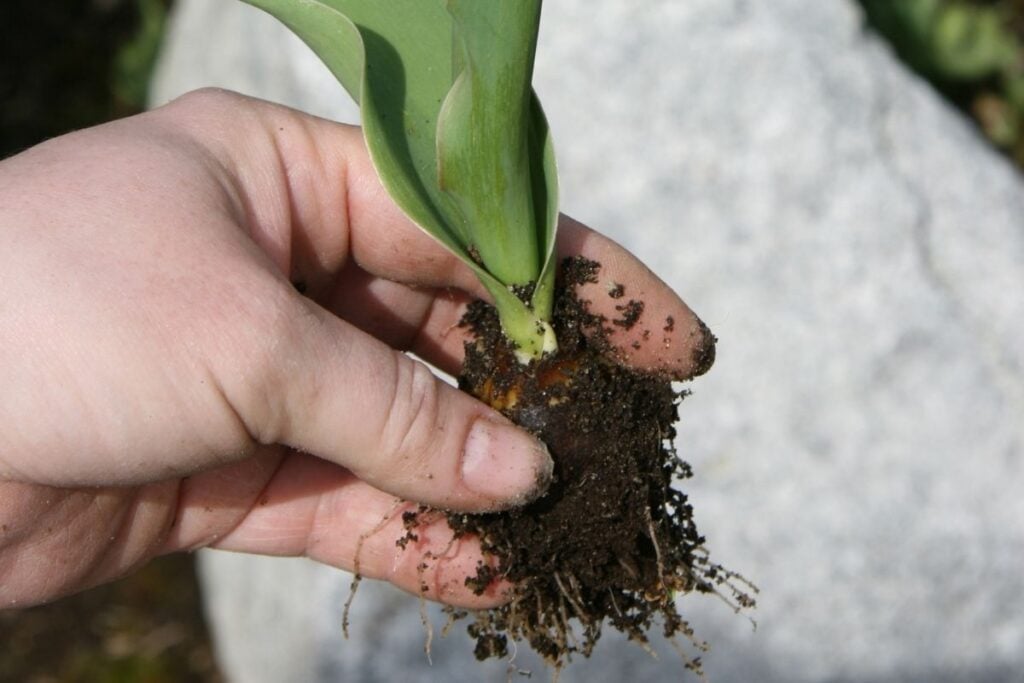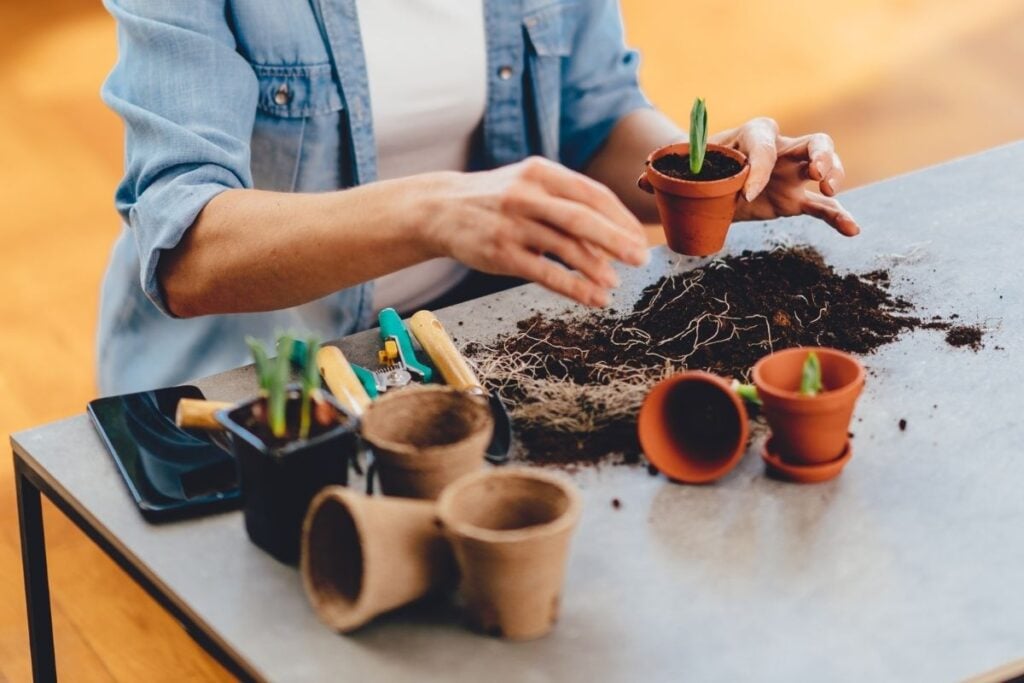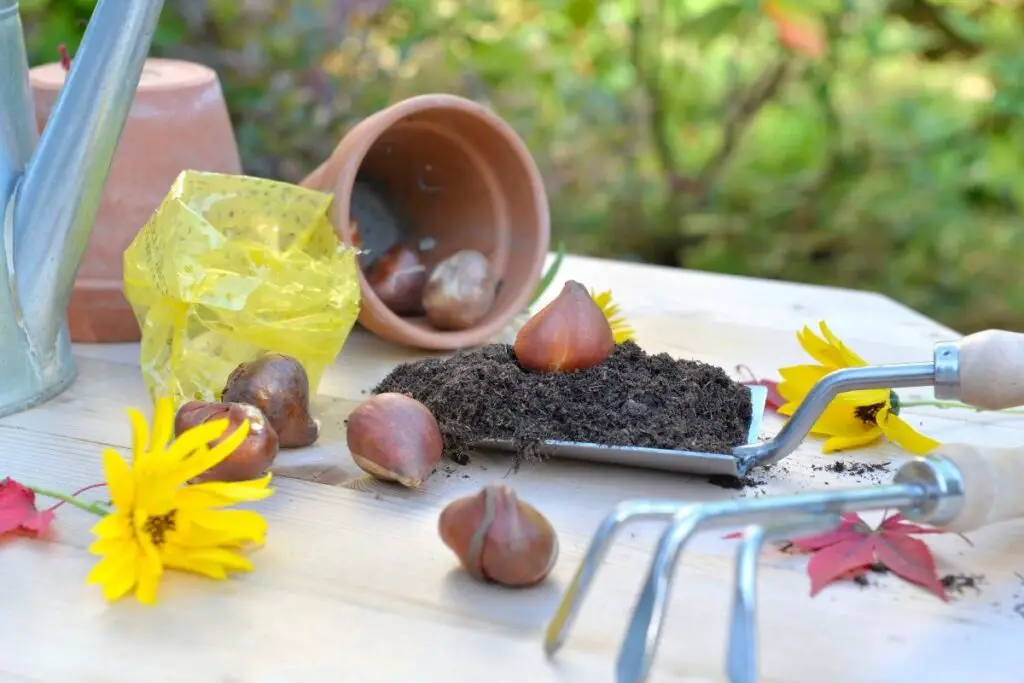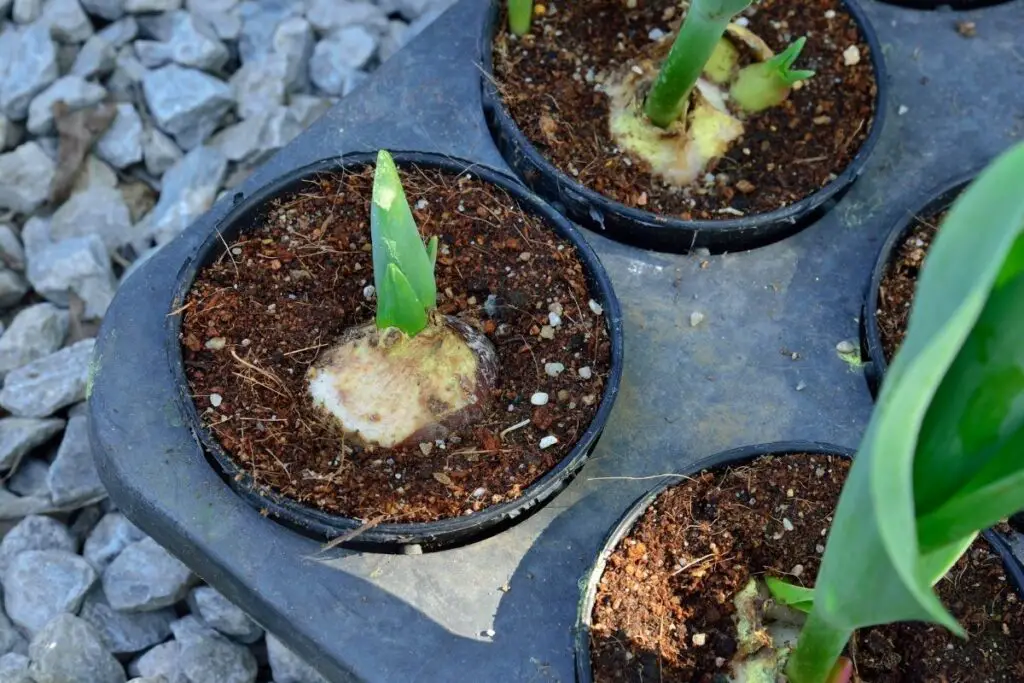It is no surprise that tulips prefer a cold climate to thrive as such an environment influences their life cycle. But we must also understand the right time to plant them so that we can get the best out of these beautiful plants.
So, today we are going to learn when’s the best time to plant tulips.
Generally, tulips need to be planted during the fall season once the temperature drops below 55°F. The planting time will depend upon the area you live. For USDA zones 3-5, you can plant them in September, for Zones 6-7, plant them in October, and for Zone 8-9, plant them in November only.
While planting tulips, it is vital to know their propagation nature, temperature preference, and the right time of their blooming. This article has explained the best time for planting tulips and the best possible care for them.

When to plant tulips?
You should plant tulip bulbs in the autumn or the fall season if we want them to brighten our days with beautiful blooms during spring. Tulips flower naturally in the spring after going through a chilling period of the winter months.
The soil needs to be cooled off after the summer growing season before planting tulips.
Tulip bulbs remain in a dormant state during summer. You should take them out of the flower bed and transport them during this time. You need to keep the tulips dry and cool throughout the process.
Tulips reproduce and bloom during spring. This is when they absorb most solar energy to maintain photosynthesis and produce food in the form of starch that remains stored in the bulbs for future use.
This stored food acts as the primary source of energy during winter.
Also read: What Temperature Do Tulips Need? (+Growing Them At Different Temperature)
Why do tulips need to be planted in the fall?
When the temperatures fall at the onset of autumn, things take a turn.
Low soil temperatures encourage a natural process that creates glucose by breaking the complex carbohydrate and starches that the plants produce with the help of photosynthesis. This glucose mixes with the water spread around the plant.
Since glucose is an anti-freeze agent, it doesn’t let the water freeze, which helps the tulips tolerate and survive the low temperatures.
When the temperatures start rising at the threshold of spring, this glucose is used for blooming. Tulips reproduce during this phase through bulbs or seeds by using the energy derived from glucose.
After several weeks of bloom, the flower and leaves wilt, leaving the bulb underground with stored food for the next cycle. The bulb enters a dormant state during the summer.
This is the reason why tulips don’t thrive in warmer places. Autumn is the period for the soil to cool down from summer heat below 55°F.
However, if you are planning for an early bloom or to grow tulips where the soil temperature does not go below 60°F, you need to pre-chill your tulip bulbs over some time before planting them in soil or water.
After knowing the accurate time for planting tulips, let’s dig more into the correct procedure for growing them.
Some basic tips for planting tulips in autumn

Plant the tulip bulbs during fall, 6 to 8 weeks before a ground-freezing frost is expected. Tulip bulbs need time to establish themselves in the changing climate. Planting the bulbs too early leads to disease problems.
- Try to plant the bulbs when the nighttime temperature falls between 40-50°F range.
- As a rule of thumb, plant the tulips in September or October, especially in the colder northern climate.
- In warmer climates, plant bulbs in December or even later.
- Don’t delay in planting the bulbs after purchase.
- In the southern hemisphere, where winter is mild, plant bulbs in late November or December. The bulbs must be chilled in the refrigerator (below 50°F) for about 12 weeks before planting.
- You can often opt for pre-chilled bulbs from bulb suppliers.
- Remember one thing. Bulbs are not like seeds. You can not keep them throughout the year for the following fall to come. So if you miss planting your tulip bulbs at the optimal time, take a chance and plant them immediately, even in January or February. Wait for the result but not for spring or next fall.
How to choose a site and prepare the soil for tulips during autumn?
Tulips prefer a site that gets full or afternoon sun. As tulips don’t like too much heat, try to choose a shady area for warmer zones (zone 7 and 8) where the average temperature is 10-20°F.
The soil must be fertile, dry, or sandy, supporting well drainage and neutral to slightly acidic. Tulips have a strong dislike for areas that hold excessive moisture.
In areas that experience strong wind currents, tall varieties should be sheltered from wind damage. You need to place the bulbs 4 to 6 inches apart, so choose a large enough site to support the plantation.
Looking for gardening supplies? We have tested 100's of products before recommending them to you guys. Check out our best pick below:
| Image | Gardening Supplies | Best Price? |
|---|---|---|
 Top
Top Top
Top | Raised Garden Bed Kit | Check On Amazon |
 | XLUX Soil Moisture Meter, Plant Water Monitor, Soil Hygrometer Sensor for Gardening, Farming, Indoor and Outdoor Plants, No Batteries Required | No Results |
 Top
Top Top
Top | 82 Pcs Garden Tools Set and Extra Succulent Tools Set | Check On Amazon |
 | Joeys Garden Expandable Garden Hose with 8 Function Hose Nozzle, Lightweight Anti-Kink Flexible Garden Hoses, Extra Strength Fabric with Double Latex Core, (50 FT, Black) | No Results |
 Top
Top Top
Top | Dual Chamber Compost Tumbler | Check On Amazon |
 Top
Top Top
Top | Sunnyglade Plant Stakes | Check On Amazon |
 Top
Top Top
Top | Organic Cold Pressed Neem Seed Oil | Check On Amazon |
 Top
Top Top
Top | Mighty Mint Gallon :-Insect and Pest Control Peppermint Oil | Check On Amazon |
 Top
Top Top
Top | Scotts DiseaseEx Lawn Fungicide | Check On Amazon |
 Top
Top Top
Top | Jacks Classic 20-20-20 All Purpose Fertilizer | Check On Amazon |
 Top
Top Top
Top | 30,000 Seeds Pollinator Attracting Wildflower Mixture | Check On Amazon |
 Top
Top Top
Top | Survival Vegetable Seeds Garden Kit-Over 16,000 Seeds | Check On Amazon |
Preparing the flower bed:
- Prepare the planting area. You can use a garden fork to relax the soil upto 12-15 inches.
- Now mix it with a layer of compost of about 2-4 inches.
- Another way is to mix 3 inches of garden soil with 6-7 inches of native soil.
- The soil’s macro elements’ nutrition will support a healthy root system and a big bloom afterward.
How to plant tulips?

Here are the steps that can help plant tulips.
- Tulip bulbs need to be planted nearly 6-8 inches deep into the soil. You can measure the depth depending on the height of the bulb. It should be three times the height of the tulips. Dig a hole deeper than the level to loosen the soil for drainage passage. In clayey soil, you need to maintain a depth of 3-6 inches.
- Place the tulip bulb inside the hole with its pointed end upward. Cover it with soil and press the soil firmly.
- Water the tulip bulbs right after planting them. Although they can’t tolerate wet feet, this step is essential for inducing growth.
- For impactful growth, plant the tulips in a group of 10 or more.
- If you expect optimum results while raising perennial variety, you need to accelerate the soil and nutrient function by applying the right plant food. Feed your plant with well-balanced fertilizers when you plant them in the autumn. The correct nutrient ratio is 9-9-6.
- You can use organic material or compost for serving the purpose. Use a mixture of blood meal, bone meal, and greensand to feed the bulbs.
Also read:
- How Much Sunlight Do Tulips Need? (Tulip Light Needs)
- How Often Do Tulips Need To Be Watered? (Tulip Watering Needs )
- What Kind Of Soil Is Good For Tulips? (Best Soil Mix)
- What Is The Best Fertilizer For Tulips? (Organic+Inorganic)
Care for tulips
After planting the tulips, you need to take care of them too.
- If the weather is dry, you should water your bulbs weekly until the ground freezes. But if it is raining daily, do not go for watering.
- Rainy summers, damp, soggy soil, and irrigation systems are a big no for tulips. They can cause death to these bulbiferous species. Damp soil invites fungus and other pathogens to the soil causing rot in the bulbs.
- Add porous material like sand, pine bark, pebbles to the soil to increase its drainage capacity.
- For perennial varieties, add compost annually to maintain an adequate nutrient supply in the soil for the tulips to use in their next bloom cycle.
- Many make a mistake by applying fertilizer into the hole when tulips are planted. Don’t do that as it will damage the newly formed roots causing them to ‘burn.’ Instead, apply food supplements to the top layer of the soil.
- When the bulb starts to bloom in the spring, new leaves start emerging. Feed your plant the same food you have applied during planting. Water it thoroughly.
- Always use a diluted or less concentrated solution.
- After the bloom, clip off the dried-out flowers. Do not trim the leaves.
- Let the leaves be on the plant for a few weeks until they naturally dry back or become yellow. Tulips need the foliage to gather energy by maintaining photosynthesis for the next bloom.
- Replanting is needed for large varieties every few years. Smaller varieties multiply on their own.
How to protect tulips?

The most challenging part of growing tulips is to protect them from different pests and animals. While deer make a good meal of tulip leaves, squirrels and chipmunks dig up the bulbs.
- If you are planting big sweeps of bulbs, the best way to protect the bulbs from squirrels is by lining the planting holes on all sides with chicken wires.
- For deer, the story is different. Install a tall fence almost about 8 feet or more to keep deer away from your plantation site. If it sounds a bit expensive, you can go for a more organic method. Interplanting Daffodil bulbs or Crown Imperial bulbs with tulips will help as deer do not eat these plants.
- You can also try saving your tulips by spraying some deer repellent on the foliage. But if deer are a massive problem at your location, plant daffodils in a pot.
- If mice or rodents like mice have been a problem, put thorny leaves in the planting holes to deter them. You can use crushed gravels too for this purpose.
If these unwelcome guests cause extreme nuisance, the best way is to use wire cages to plant bulbs.
What is the best pot for tulips?
While growing tulip in a pot, you need to know the exact size of the medium. A 6-inch diameter or larger pot with proper draining holes underneath will serve the purpose well. Check the porosity of the soil mix.
Dig a 2 inches deep hole and follow the same planting instruction mentioned above.
Why are my tulips not blooming?
Tulips that go through cold treatment often experience this issue. An unhealthy bulb or improper cold treatment are the general causes.
If the bulbs are subjected to the forced-blooming previous year, they may not have adequate nutrients stored to support reblooming.
The inappropriate temperature during cold treatment is another good cause that can prevent blooming. Temperature below 32°F and above 40°F causes bloom failure.
Store the bulbs in sealed bags and add some moistened peat moss in the packet so that the bulbs do not get dry as dried-out bulbs are equal to dead bulbs.
How to water tulips?
Watering tulips at the initial stage of planting is essential. Afterward, the rain and snow of the winter months accelerate its growth.
- Water at least once every week for the first month after planting. Leave it alone until the leaves come out. The water should spread through the entire soil.
- Resume the watering schedule again during springtime.
- Every time you water the tulips, make sure that the water drains out completely.
FAQ
How long do potted tulips last?
Perennial tulips usually live for several years, reblooming in every spring. Their regrowth depends on the climate you are living in.
Proper watering, storing methods, and deadheading them before the seeds are developed are some of the care tips that can support a long life for your favorite tulips.
Tulips have a higher chance of having a prolonged life span in cold winter and dry summer areas.
Do potted tulips need sunlight?
Absolutely! Once they start to grow, they require sufficient sunlight to gather energy until they bloom fully.
How can overwatering be prevented?
Overwatering is the most prominent reason for tulips to wilt. To prevent overwatering, besides inspecting the pot’s drainage holes, put a layer of draining medium at the bottom of the pot. It can be rocks or draining discs.
Use organic compost soil over the bulbs in a layer three times the bulb’s height.
How to make your tulips stand upright?
If your tulips look too bendy, you can use a simple trick to make them stand straight. Wrap a piece of paper around the bunch. Cover the flowers too. Make sure the edge touches the soil or water.
Soak them in water and wait for at least an hour before removing the paper. You will witness your tulips gracefully standing straight. This happens as the tulips absorb water that causes a rise in the turgor pressure.
Keeping your tulips in a cooler room with indirect sunlight will also prevent bending.
If your room gets proper sunlight or has any heating source, there is a potential chance for your tulips to bend towards that source due to their natural nastic movement. You can’t prevent that.
Source: Wikipedia, North Dakota Stae University, The Royal Horticultural Society.
